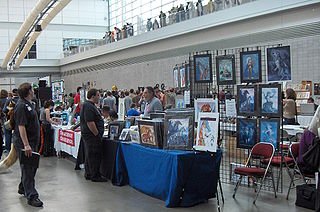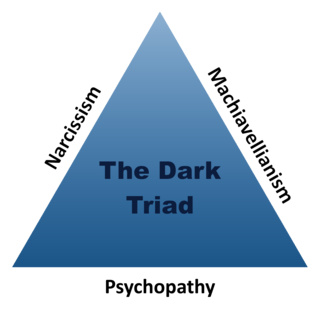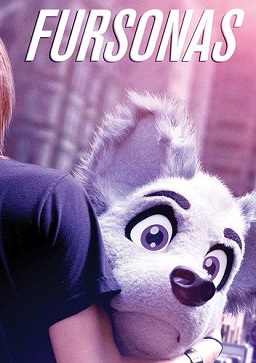
The furry fandom is a subculture interested in anthropomorphic animal characters. Some examples of anthropomorphic attributes include exhibiting human intelligence and facial expressions, speaking, walking on two legs, and wearing clothes. The term "furry fandom" is also used to refer to the community of people who gather on the Internet and at furry conventions.

Fursuits are custom-made anthropomorphic animal costumes owned and worn by cosplayers and members of the furry fandom, commonly known as "furries"; a furry who wears a fursuit is called a fursuiter. The term is believed to have been coined in 1993 by Robert King. Unlike mascot suits, which are usually affiliated with a team or organization, fursuits represent an original character created by their wearer, and are often better-fitting and more intricately crafted, with features such as a moving jaw. Fursuits are made in a wide range of styles, from cartoonish to highly realistic.

Albedo Anthropomorphics, or Albedo for short, is a furry comic book anthology series which was credited with starting the furry comic book subgenre that featured sophisticated stories with talking animals primarily intended for an adult audience. The first issue of Albedo was published in 1983; the most recent issue was published in 2005.

Otto Friedmann Kernberg is an Austrian-born American psychoanalyst and professor of psychiatry at Weill Cornell Medicine. He is most widely known for his psychoanalytic theories on borderline personality organization and narcissistic pathology. In addition, his work has been central in integrating postwar ego psychology with Kleinian and other object relations perspectives. His integrative writings were central to the development of modern object relations, a school within modern psychoanalysis.
Global citizenship is the idea that one's identity transcends geography or political borders and that responsibilities or rights are derived from membership in a broader class: "humanity". This does not mean that such a person denounces or waives their nationality or other, more local identities, but that such identities are given "second place" to their membership in a global community. Extended, the idea leads to questions about the state of global society in the age of globalization.

Frederick Walter Patten was an American writer and historian known for his work in the science fiction, fantasy, anime, manga, and furry fandoms, where he gained great distinction through a substantial contribution to both print and online books, magazines, and other media.

A furry convention is a formal gathering of members of the furry fandom – people who are interested in the concept of fictional non-human animal characters with human characteristics. These conventions provide a place for fans to meet, exchange ideas, transact business and engage in entertainment and recreation centered on this concept. Originating in California, United States, during the mid-1980s, as of 2016 there are over 50 furry conventions worldwide each year.

Midwest FurFest (MFF) is a furry convention that takes place in Rosemont, Illinois, usually on the second weekend after Thanksgiving. MFF is presented by Midwest Furry Fandom Inc, an Illinois Educational Not-For-Profit Corporation that exists primarily for the purpose of holding an annual convention to facilitate education in anthropomorphic literature and art. It also facilitates the donation of funds to non-profit institutions, mainly of which promote the well-being of humans and/or animals. The convention was first held in 2000 and has grown to draw 15,547 attendees in 2023. As of December 2023, the 2023 event is the most attended convention in fandom history.

Plushophilia is a paraphilia involving stuffed toy animals. Many plushophiles modify their plushies with a hole or holes reminiscent of those found in sex toys, to allow them to sexually interact with their plushies. Plushophiles are sometimes called plushies, although this term (plushies) can also refer to non-sexual stuffed toy animal enthusiasts, and to stuffed toy animals in general. It is a form of object sexuality.

The dark triad is a psychological theory of personality, first published by Delroy L. Paulhus and Kevin M. Williams in 2002, that describes three notably offensive, but non-pathological personality types: Machiavellianism, sub-clinical narcissism, and sub-clinical psychopathy. Each of these personality types is called dark because each is considered to contain malevolent qualities.

Anthropomorphism is the attribution of human traits, emotions, or intentions to non-human entities. It is considered to be an innate tendency of human psychology. Personification is the related attribution of human form and characteristics to abstract concepts such as nations, emotions, and natural forces, such as seasons and weather. Both have ancient roots as storytelling and artistic devices, and most cultures have traditional fables with anthropomorphized animals as characters. People have also routinely attributed human emotions and behavioral traits to wild as well as domesticated animals.
Otherkin are a subculture of people who identify as partially or entirely nonhuman. Some otherkin believe their identity derives from spiritual phenomena, ancestry, symbolism, or metaphor. Others attribute it to unusual psychology or neurodivergence and do not hold spiritual beliefs on the subject.
In psychology, grandiosity is a sense of superiority, uniqueness, or invulnerability that is unrealistic and not based on personal capability. It may be expressed by exaggerated beliefs regarding one's abilities, the belief that few other people have anything in common with oneself, and that one can only be understood by a few, very special people. The personality trait of grandiosity is principally associated with narcissistic personality disorder (NPD), but also is a feature in the occurrence and expression of antisocial personality disorder, and the manic and hypomanic episodes of bipolar disorder.
In social psychology, collective narcissism is the tendency to exaggerate the positive image and importance of a group to which one belongs. The group may be defined by ideology, race, political beliefs/stance, religion, sexual orientation, social class, language, nationality, employment status, education level, cultural values, or any other ingroup. While the classic definition of narcissism focuses on the individual, collective narcissism extends this concept to similar excessively high opinions of a person's social group, and suggests that a group can function as a narcissistic entity.
Erotic target location error (ETLE) is a hypothesized dimension for paraphilias, defined by having a sexual preference or strong sexual interest in features that are somewhere other than on one's sexual partners. When one's sexual arousal is based on imagining oneself in another physical form the erotic target is said to be one's self, or erotic target identity inversion (ETII).

A human–animal hybrid and animal–human hybrid is an organism that incorporates elements from both humans and non-human animals. Technically, in a human–animal hybrid, each cell has both human and non-human genetic material. It is in contrast to an individual where some cells are human and some are derived from a different organism, called a human-animal chimera.

Fursonas is a documentary film regarding the furry fandom which released In January of 2016 and was directed by Dominic Rodriguez with Producer Olivia Vaughn and Christine Meyer as Editor, among others.
Simine Vazire is Professor of Psychology Ethics and Wellbeing at the University of Melbourne, Victoria, Australia. She was formerly Professor of Psychology at the University of California, Davis and at Washington University in St. Louis. She is a social and personality psychologist who studies how self-perception and self-knowledge influence one's personality and behavior. She obtained a PhD in the social and personality psychology program at the University of Texas at Austin.

Anthro New England (ANE) is a furry convention that is held in the Greater Boston area of the U.S. state of Massachusetts. It was first held in 2015 in Cambridge, Massachusetts, but moved to the Boston Park Plaza in 2018 and has been held in Boston annually since then. For 2023, Anthro New England is now being held at the Westin Boston Seaport Hotel. The 2021 event was held online due to the COVID-19 pandemic. The latest event in 2023 reached a new attendance record of 3,548 attendees.

Ironclaw is a series of tabletop role-playing games created by Jason Holmgren of Sanguine Games, this series features anthropomorphic characters in a setting inspired by class and religious conflicts during the Italian Renaissance. Additionally, Jadeclaw is a related game that is set in a concurrent East Asian setting.













